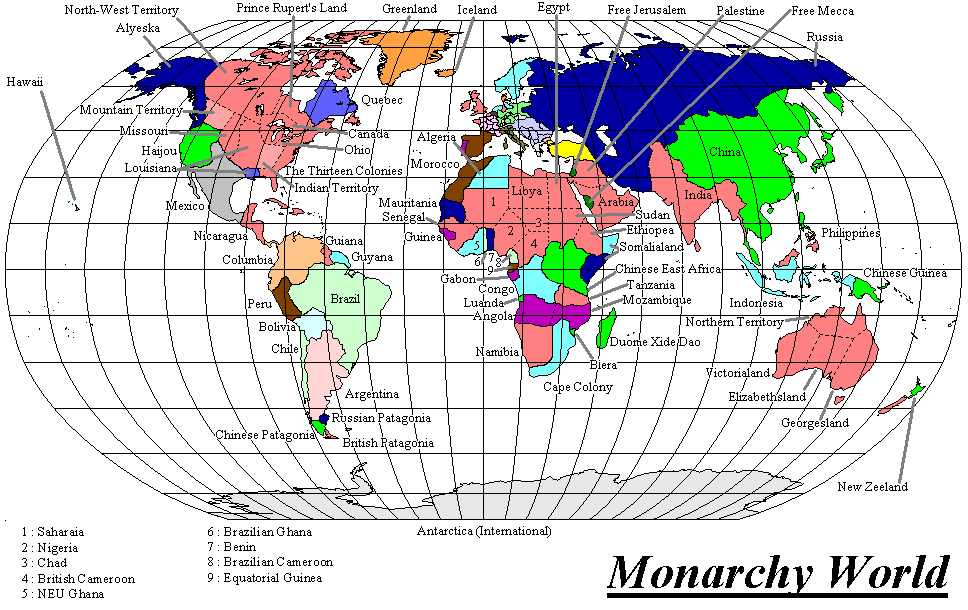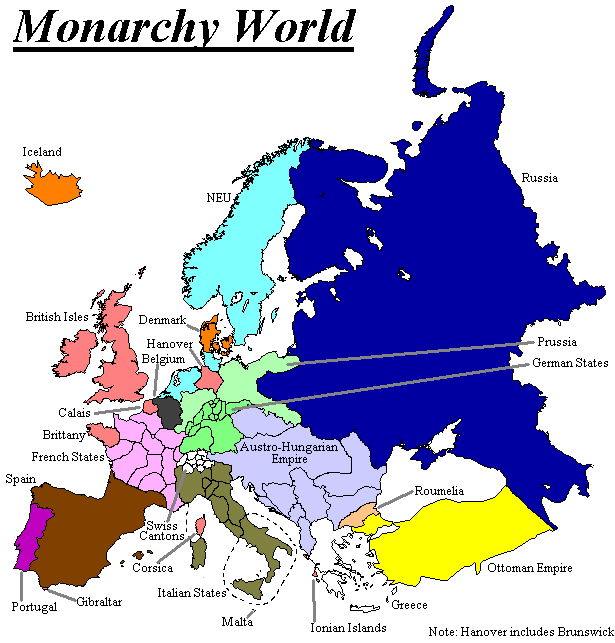

THE WORLD

 |
THE WORLD |
 |
OVERVIEWMost of the world is divided between the three Great Powers. Britain has the largest Empire in terms of land, with the Russian Empire the second-largest, and China the third. However, China has the highest population (more than a billion of the world's four billion people). Britain has the second highest population, a great deal of it concentrated in India, with Russia the third. Russia is top in science and technology, with Britain and China roughly equal. China is top in agriculture. Britain is top in heavy industry. These three empires together are sometimes known as the Triumvirate. The fourth most powerful nation, the NEU (an alliance of the Netherlands, Sweden, and some German states) also holds a considerable empire, with quite a large population, but cannot rival any of the three Great Powers. The Spanish and Portuguese Empires still exist, but are small, weak and run-down. The Portuguese colonies, Angola and Mozambique in particular, are regarded as run-down hellholes. South and Central America are not dissimilar to the real world; over time the various nations there broke away from Spain and Portugal, leaving only Peru in Spanish hands. Spain also retains its colony of Morocco. There is an Empire of Mexico, which is quite powerful and stable, after instability in its initial years of independence. It is an almost theocratic Roman Catholic state. France, Germany, Switzerland and Italy are all collections of small states, with mixed alliances. France's fragmentation prevented the unification of Italy. Some of the German states have mutual defence pacts but also have alliances with external powers that stop full unification. Switzerland is also still a collection of separate cantons. Malta and the Ionian island remains British, as do Corsica, Hanover, Brunswick, Gibraltar, Calais and Brittany. Poland does not exist; it was divided between Russia, Austria and Prussia in the late eighteenth century. The Ottoman Empire still exists, though in 1995 it is little more than real-world Turkey, the rest of it having been nibbled away in wars over the years. It is easily the most primitive and reactionary of the world Powers. The Austro-Hungarian Empire also still exists. By 1995 it is little more than a loose confederation of the former states of the Austro-Hungarian Empire (Czechoslovakia and so on). However, it is also, quite free, intellectually, and has been for some decades. For this reason some of the more influential scientific breakthroughs of the twentieth century (such as quantum mechanics) have emerged from the Austro-Hungarian Empire. Parts of Africa were originally taken over only because they were crucial parts of the Indian trade routes. Other than that up until WWII the presence of the Great Powers in Africa was semi-random. Some parts of Africa were colonised for trade, as fuelling stations and for strategic reasons (for example, around the Cape and Russian Mauritania), but many parts of it remained unclaimed by any of the powers until during WWII. MAPS OF THE WORLD |
 |
 |
|
|
||||||||||||||||
|
The overall economic system of the world is closer to what, in the real world, would be called Mercantilism than real-world Capitalism. However, unlike pure Mercantilism, reliance on bullion alone has been replaced by reliance on all things of value to an empire, including intangible things such as the intellect of its people, leading to the evolution of a system known as commodityism (or chattelism to its detractors). Because communism or similar systems have not been used to run any of the nations of the world, but there has still been a great deal of competition between the Great Powers, the world, taken as a whole, is rather richer than the real world. The empires maintain a good deal of control over those areas which they consider essential to the running of the empire. This includes the areas of media, transport, and infrastructure generally. They also fund most research which takes place, via the universities. However, outside of these areas there is also a thriving world of commerce and technological development, generally only within a given empire, but still with a great deal of room for competition, capitalistic behaviour and so on. And plenty of opportunity for companies to sell to their respective government, obtain government contracts and so on. It is not, however, unknown for particularly successful businesses which come to be seen as essential to the empire, such as the telephone business, to be nationalised by their government. There is no third world, and nowhere is particularly isolated. The nicknames of the various Powers replace the first, second and third worlds of the real world. The population of the entire world is approximately four billion people. Active population control measures are being undertaken in some places, mainly on the non-white or non-Chinese inhabitants of colonial areas who are seen as breeding too much. However, much of the reduction in birth rates has been achieved through greater overall prosperity and levels of education leading to people wishing to have smaller families. Slavery still exists in some parts of the world, particularly Louisiana, Brazil and Mexico, but also to a lesser extent in other parts of Latin America as well as some African and other colonies (Portuguese and Spanish ones particularly). Slavery still exists 'unofficially' is some areas of the Great Powers too, such as the Middle East and Russian Mauritania. Attempts have been made to stamp it out, which has halted the trans-Atlantic slave trade (while leaving nations with their own internal slave markets), but in general apart from a small number of anti-slavery campaigners, slavery is considered an internal matter, with which other nations should not interfere. London is the second largest city in the world, after Beijing. London itself is larger than in the real world; the central streets are basically the same, but further out they vary more between the old villages. London is prettier than in the real world, but even it has some ugly buildings, built in the severity of the post-WWII depression years to fill bombed sites. Tower blocks do exist in some places, but in general slum clearance has involved building better housing on the slums and moving people out to new suburban developments. There is a London Underground, the largest and most extensive underground railway system in the world. The lines and stations are different to those in the real world, and more extensive. Many other cities in the British Empire, and other nations too, also have tube systems. The former coaling stations of the Great Powers are scattered world-wide. Although no longer used for coaling, most of them are now military bases of one type or another. There are British ones on islands between Central America, New Zealand and Australia, plus the British Philippines, India, Africa and so on. Chinese ones extend across to Chinese America, including the Hawaiian Islands. Russia holds the Kuriles. The more important of these stations are massively defended, and known as Imperial Fortresses. Antarctica has been divided up among all the nations of the world, in pie-slices from coast to middle, the size of the slice depending (essentially, though it is put in higher-sounding terms than that) on the power of the nations. So the three super-powers have the majority, with the other nations smaller slices of varying size. Of course, no-one actually has the technology to exploit it yet, but... The same thing has been done to the Moon and the other planets. All of the Great Powers have colonies on the Moon, for mining and scientific purposes, and a number of space stations in orbit around the Earth. Some of these are military in nature; some of them are laboratories or factories. Britain has a research station on Mars. All three Great Powers have small research bases in the Asteroid Belt. Most cities have nuclear fallout shelters, often associated with tube systems. The southernmost Russian harbour on the Pacific is at Okhotsk. It is a big military base. In China Military Road #1 runs around the Chinese border with Russia and the British Empire, apart from where it is utterly infeasible to do so. There is a similar railway on the Russian side of the border. There are large 'no-mans lands' along many of the borders of the Great Powers with one another. COUNTRIES OF THE WORLDThese are divided by continent.
Note that what is listed as a single nation or colony above may well have internal subdivisions; the list above contains single contiguous areas under the control of one nation. OTHERThe French-speaking nation of Louisiana has some of the most innovative cuisine in the world, mixing Chinese, Spanish, Indian (subcontinent and native American) and Mexican influences. All of the nations of the world have lots of war memorials commemorating the dead from all three world wars. The official (and only) broadcaster in the British Empire is the BBC. It is responsible for radio and television transmissions of all kinds. The Post Office runs the British postal service, telephone network and internet. There are no independent service providers. The main industrialised areas of the British Empire are the British Isles themselves, British North America and India. There are a number of groups of organised criminals. These are a mixture of Chinese triads, some Mafia-types, Indian Thugee-types, London criminals, Japanese Yakuza and so on. Allegedly the triads are the most powerful and widespread of these criminal organisations, and (allegedly) have Indian as well as Chinese members. The biggest computer company in the British Empire, and perhaps the world, is Imperial Calculating Engines (ICE). Go to the Monarchy World Timeline, or the Politics, Society, Technology or Differences Pages. Back to the Monarchy World Home Page.
| |||||||||||||||||